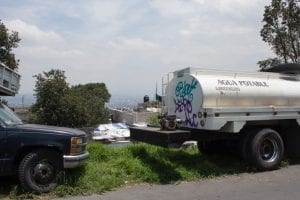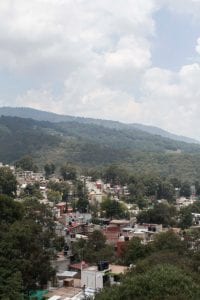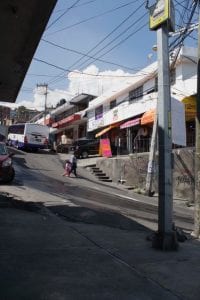Jack Mensik, MA Student, LACS
“This is the water!” Elena exclaimed. She scurried back to the living room from the kitchen and excitedly set the glass down on the table in front of me.
“Wow, it looks pretty clean,” I responded. I was not exaggerating. Specks of distant sunlight shimmered in the translucent water, whose unblemished appearance belied the fact that it had been collected from rainfall in a city notorious for its air pollution. For the past few years, Elena and her husband, Antonio, have relied on a household rainwater harvesting system to meet a substantial portion of their family’s water needs. Isla Urbana, an organization dedicated to the proliferation of rainwater harvesting in Mexico City, designed and installed this system, which captures water from Elena and Antonio’s roof, passes it through a series of filters, and stores it in a 5000-liter plastic cistern in their backyard. In their kitchen, another set of filters purifies the water to a quality suitable for drinking. They’ve done tests, Elena told me, and the quality is consistently excellent.
Figure 1. A household rainwater harvesting system that serves as an important source of clean water for residents of Mexico City’s periphery.
In truth, the clean water contained in the glass offers Elena and Antonio more than just good health. It affords them the possibility for a stable livelihood amidst circumstances in which they enjoy only marginal access to the rights and privileges promised to citizens of North America’s largest city. Reliance on the rain has meant that the family is no longer at the mercy of a government that is unsure of whether their household is deserving of piped water service. Yet, as Elena beamed with pride over the immaculate glass, I also wondered whether this newfound stability would make their otherwise rightless status more tolerable. After all, why would the family bother to seek legal recognition from government authorities if a public service like water was no longer urgently needed?
Elena and Antonio’s lack of formal land tenure explains how they discovered rainwater harvesting, and why they are so enthusiastic about it. The family’s home sits in a rolling mountain valley on the southern periphery of Mexico City within the city’s “ecological zone”, a conservation area in which human habitation is prohibited. Elena, Antonio, and their young children settled the unoccupied piece of land without legal sanction in the early 2010s. The growing family had become too big for their small house in San Gregorio Atlapulco, an urbanized area located a few miles away in the borough of Xochimilco. They had to build a home from scratch on the mountainside, but they found relief from the cramped conditions in which they had been living. Yet, because they had illegally occupied their land, they were ineligible for almost all government services. Elena and Antonio felt the absence of piped water most acutely. They narrowly missed an opportunity to enroll in a municipal program that would have offered them a monthly delivery from water trucks (locally known as pipas) at a subsidized cost. Meanwhile, the full cost of a monthly pipa delivery was more than they could afford on a regular basis. So, they would make trips down to a pump in San Gregorio, fill up a half-dozen or so 19-liter jugs with water, and either hire a taxi to bring them home or haul the jugs back uphill themselves in a cart. It was tiresome work, but unless the city government redesignated their community’s land tenure status as part of the “urban zone”, rather than the “ecological zone”, avenues for improvement remained limited.
Figure 2. An example of a pipa, or water tanker truck, that delivers water to many of Mexico City’s residents.
Elena and Antonio’s decision to seek a better life on Mexico City’s geographic and legal periphery repeats a logic that has been commonplace in the city for nearly a century. Since the end of the Mexican Revolution in 1917, inner-city residents have looked to the city’s periphery as a place where single-family home ownership could be realized, far from predatory landlords, burdensome rents, and squalid living conditions. Meanwhile, since the end of the Second World War, informal settlements on the periphery have also absorbed influxes of rural migrants seeking economic opportunities in the national capital. Over time, many informal communities have received legal recognition from the state, and have been integrated into the city through the extension of public services. These patterns of migration, settlement, and eventual legalization have played a key role in the Mexico City’s rapid expansion from a contained city of 369,000 in 1900 to a sprawling megalopolis of over 20 million today.[1]
Yet, city and municipal governments are often hesitant to recognize informal settlements. In decades past, officials marshaled concerns about sanitation as a justification. Today, environmental considerations, specifically those surrounding water, occupy a central role in government discourse. The vast majority of the “ecological zone” occupies territory in the southern portion of Mexico City comprised of rural towns, farms, and mountain forest. The area’s vegetation plays a vital role in absorbing rainfall and recharging the subterranean aquifer upon which the metropolis depends for its water supply. Authorities are concerned that unrestricted settlement will lead to urban sprawl and loss of this important green space. [2] These apprehensions are justified, as the future of Mexico City’s water supply looks bleak. Decades of intensive extraction to quench the city’s thirst, coupled with miles of paved surfaces that prevent replenishment, have severely diminished water levels in the aquifer. In fact, this drop has caused parts of Mexico City to physically subside—the sight of uneven streets or buildings tilted at alarming angles are fairly common. Aqueducts that supplement the city with water from neighboring states are inefficient and costly.[3] Indeed, Mexico City is running out of water, and years of unsustainable growth have threatened the city’s survival.
Figure 3. The “ecological zone” found prominently in southern Mexico City in which vegetation plays a vital role in absorbing rainfall and recharging the subterranean aquifer.
However, the city’s vigilance over the aquifer also means that residents living in hundreds of informal settlements within the “ecological zone” are unlikely to receive the adjusted land tenure that will be necessary for basic improvements in water services and infrastructure. “It puts us in a dilemma,” one municipal official told me, “because on one hand, [water] is a right that everyone has. But by beginning to recognize these irregular communities, then what becomes of the conservation of natural land? Yes, [water] is a right, we cannot deny it. But also, there are certain limits that we cannot exceed through our actions.”[4]
Isla Urbana’s rainwater harvesting systems offer one solution to this dilemma, as the contraptions can expand water access without placing additional stress on the aquifer. “Rainwater harvesting gives you a tool that you can select exactly the houses or neighborhoods that are most problematic, or for any reason the city has failed to supply adequately,” explained the organization’s founder, Enrique Lomnitz. If these water stressed areas are supplemented with rainwater, he reasoned, it would reduce the burden on Mexico City’s water supply and infrastructure.[5]
Most of Isla Urbana’s work consists of government-sponsored programs, in which they install rainwater harvesting systems in formally recognized communities where water infrastructure performs poorly. Yet, through private donations, Isla Urbana is also able to service informal communities, many of which are in the “ecological zone.”[6] After connecting with Isla Urbana through mutual acquaintances, Elena and Antonio rounded up enough interested neighbors to begin a project of their own. The couple had to pay 3050 pesos (about $150 US dollars) to cover part of the cost of their own system, but they began harvesting rain shortly after its installation.
So far, Elena and Antonio are thrilled with the results. During Mexico City’s rainy season, roughly between June and October, powerful rains fill their cistern up with water that lasts into the dry season, meaning they save money they spent on pipas and time they spent on trips to the water pump. In the coming years, the couple hopes to expand their storage capacity so that their supply will last even longer. “To this day, we don’t suffer from water,” Antonio declared, “The system is very good and it has helped us a lot.”[7]
While rainwater harvesting has brought greater stability and comfort, the couple still expressed a desire for legal land tenure and improved infrastructure. They would like to see some form of piped water service, or at least more pipa trucks. “We all have rights to these things,” Elena argued, “Just as we have a right to light, we have a right to water. We have rights to urban services. And just because we live up here doesn’t mean we have no rights. We have the same rights as those who live down [in the city].”[8]
I sensed a gap, however, between Elena and Antonio’s belief that they had these rights and their ability to live without them. Previously, I had spoken with numerous residents of formally recognized communities, most of whom saw rainwater harvesting as more of a temporary fix that could never truly substitute for efficient piped water service. Elena and Antonio, on the other hand, seemed committed to rainwater harvesting for the long-term and relatively unfazed by the improbability of infrastructural improvement in their community. When I asked them why, they stated that they were concerned about the dwindling aquifer, and felt that rainwater harvesting and water conservation were essential steps for a better future. Even if their land tenure changed and services arrived, they said, they would continue to harvest rainwater. “We have [rainwater harvesting], it has helped us a ton,” Elena explained, “But yes, if piped water came, then that too. But also…as we said before we have to be conscious, right? Although we have piped water, save it, right? Take care of it.”[9]
Residents of other informal settlements echoed Elena and Antonio’s enthusiasm for rainwater harvesting, as well as their ambivalence toward legal land tenure and improved service. “I am doing very well with rainwater harvesting. I’d neither ask nor demand much else,” one woman told me, “If they come to tell us, ‘Guess what? They’re going to install pipes,’ I’d say, ‘Well, That’s fine. That’s good, isn’t it?’ But if not, then no. Because…with the rainwater harvesting system, well, the truth is that I’m fine.”[10]
Others expressed a similar dedication to rainwater harvesting on account of environmental concerns. “Sure, I would like to see it regularized,” one man said, “but I will keep collecting rainwater. Yes, I would keep doing it. Why? Because this way I am helping out the environment a bit, I’d say. Because sometimes you talk and you don’t do much…”[11]
These comments reveal the extent to which Mexico City’s water crisis is not simply an environmental issue, but cuts to the core of the city’s longstanding struggle with social inequality. Rainwater harvesting appears to do an excellent job of meeting informal residents’ water needs, and provides them with a greater sense of security that they can remain in their homes for the immediate future. Yet, the systems do not resolve critical legal issues surrounding land tenure in informal settlements that would establish permanent residence. Residents’ ambivalence toward resolving these issues may simply reflect doubt that their day of recognition will ever come. Their passion for rainwater harvesting is inspiring, but laden with resignation toward a tolerable, but rightless, livelihood on the periphery.
Both authorities and residents of Mexico City care deeply about their city’s environmental future. However, reaching a sustainable solution to an increasingly dire water crisis will require reckoning with difficult questions about what it means to be a full citizen of Mexico City and who can acquire this status. Until then, every raindrop that falls in the Valley of Mexico will be worth saving.
[1] Matthew Vitz, City on a Lake: Urban Political Ecology and the Growth of Mexico City (Durham, NC: Duke University Press, 2018), 4, 89-92; Thomas Benjamin, “Rebuilding the Nation,” in The Oxford History of Mexico, ed. William H. Beezley and Michael C. Meyer (New York: Oxford University Press, 2010), 470; Wayne Cornelius, Politics and the Migrant Poor in Mexico City (Stanford, CA: Stanford University Press, 1975), 16-17, 27-28.
[2] Jill Wigle, “The ‘Graying’ of ‘Green’ Zones: Spatial Governance and Irregular Settlement in Xochimilco, Mexico City: Irregular Settlement in Xochimilco, Mexico City,” International Journal of Urban and Regional Research 38, no. 2 (March 2014): 573–89, https://doi.org/10.1111/1468-2427.12019.
[3] Barkin, David. 2004. “Mexico City’s Water Crisis.” NACLA Report on the Americas 38, no. 1: 24-28. http://dx.doi.org/10.1080/10714839.2004.11722401; Connolly, Patricia. 1999. “Mexico City: Our Common Future?” Environment and Urbanization 11, no. 1 (April): 53-78. https://doi.org/10.1177/095624789901100116; Kahn, Carrie. “Mexico City Goes Days Without Water During Maintenance Shutdown.” NPR.Org. Accessed November 10, 2018. https://www.npr.org/2018/10/31/662786981/mexico-city-goes-days-without-water-during-maintenance-shutdown.
[4] Interview, August 27, 2018.
[5] Interview, August 14, 2018.
[6] Interview, August 14, 2018.
[7] Interview, August 24, 2018.
[8] Interview, August 24, 2018.
[9] Interview, August 24, 2018.
[10] Interview, August 22, 2018.
[11] Interview, August 15, 2018.




